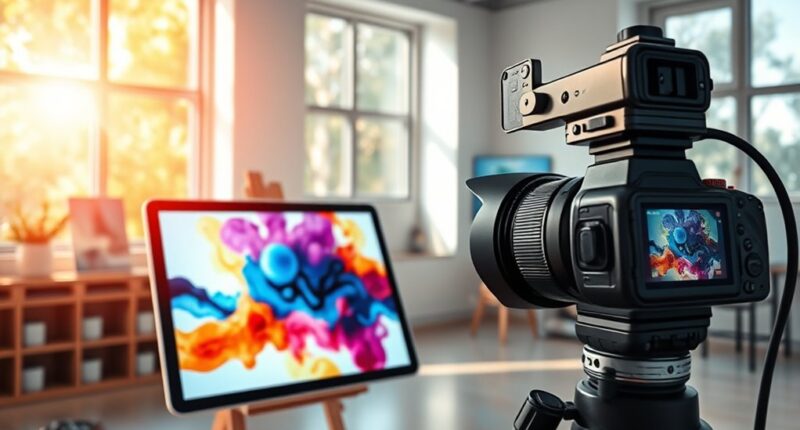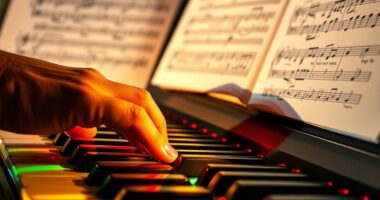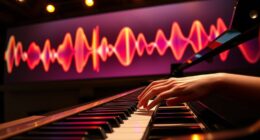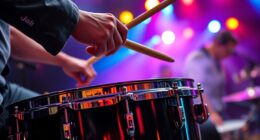Ai-assisted composition allows you to collaborate seamlessly with algorithms that analyze, generate, and refine your creative work. You can explore new musical or artistic horizons by guiding and adjusting AI outputs, blending human intuition with machine intelligence. These tools make the process intuitive and accessible, helping you overcome creative blocks and experiment with different styles. If you keep exploring, you’ll discover how AI can open your full artistic potential and inspire innovative collaborations.
Key Takeaways
- AI acts as a collaborative partner, enhancing creativity through algorithmic generation and refinement of musical and artistic works.
- Users can guide, adjust, and blend AI outputs, enabling dynamic, iterative composition processes without coding skills.
- AI analyzes existing styles to generate original content, inspiring new genre blends and innovative artistic expressions.
- Creative collaboration with AI expands possibilities, overcoming blocks and unlocking full artistic potential.
- Intuitive platforms facilitate seamless human-AI interaction, fostering experimentation and rapid exploration of new ideas.

Have you ever wondered how artificial intelligence is transforming the way we create music and art? It’s changing the landscape of creative expression, allowing artists to explore new horizons through innovative tools. AI isn’t just a passive assistant; it’s becoming a collaborative partner that enhances your creative process. When you work alongside algorithms, you’re engaging in a form of creative collaboration that pushes the boundaries of traditional artistry. This partnership enables you to experiment with sounds, styles, and ideas you might not have discovered on your own. Instead of replacing human ingenuity, AI acts as a catalyst, expanding your palette of possibilities and inspiring fresh approaches to composition.
At the core of AI-assisted composition is the concept of algorithmic creativity. It involves using machine learning models trained on vast datasets to generate original musical or artistic content. These algorithms can analyze patterns, structures, and nuances within existing works, then produce new material that aligns with your preferences or pushes them in unexpected directions. As you interact with these systems, you can guide the process—adjusting parameters, selecting outputs, or blending AI-generated snippets into your work. This synergy allows you to harness the power of algorithms without losing your personal touch, creating a seamless fusion of human intuition and machine intelligence.
The beauty of this approach lies in its accessibility. You don’t need to be a coding expert to leverage AI tools; many platforms offer intuitive interfaces that make it easy to experiment. Whether you’re composing a melody, designing visual art, or crafting soundscapes, AI provides a rich source of inspiration. It can generate multiple variations based on your input, which you can then refine and customize. This iterative process fosters a dynamic form of creative collaboration, where both human and machine contribute to the final piece. It’s like having a collaborative partner who offers endless ideas and options, encouraging you to push past creative blocks and explore new styles.
Furthermore, AI’s ability to analyze and mimic artistic patterns opens up exciting possibilities for innovation. You can blend genres, remix styles, or create hybrids that blend different cultural influences effortlessly. The algorithmic creativity embedded in these tools means you’re no longer confined to traditional methods—you can venture into uncharted artistic territories. Additionally, understanding how flushing mechanisms work can inspire new ways to approach the integration of technology and design in your creative projects. As you embrace AI-assisted composition, you’ll find that your creative process becomes more flexible, faster, and often more surprising. Ultimately, this partnership empowers you to unlock your full potential, cultivating a richer, more diverse artistic voice that’s enhanced by the capabilities of technology.
Frequently Asked Questions
Can AI Fully Replace Human Composers?
AI can’t fully replace human composers because of the unique touch of human creativity and emotion. Algorithmic creativity helps enhance your work, but human AI synergy leads to richer, more authentic music. You bring intuition, personal experience, and emotional depth that algorithms can’t replicate. Together, you and AI can push boundaries, but the human element remains essential for true artistic expression and originality in composition.
What Are the Ethical Implications of AI in Music?
You know what they say, “Every coin has two sides.” AI in music raises ethical concerns like copyright issues and artist attribution. When algorithms generate music, you must consider who owns the rights and who gets credit. Using AI responsibly involves transparent attribution and respecting creators’ contributions. Ignoring these issues could undermine artists’ rights and creativity, so it’s vital to navigate AI’s role ethically in music creation.
How Does AI Influence Creative Originality?
AI influences your creative originality by offering powerful machine learning tools that enhance your musical ideas. It acts as a partner in creative collaboration, helping you explore new sounds and styles you might not have considered alone. While it expands your creative possibilities, it also challenges you to maintain your unique voice amid the algorithms. Embrace AI as a collaborator, but stay true to your artistic vision to preserve originality.
What Tools Are Best for Beginners in AI Composition?
Imagine stepping into a vibrant studio where algorithmic improvisation sparks your creativity. As a beginner, tools like Amper Music and AIVA make it easy to generate melodies and experiment with generative sounds. These platforms offer simple interfaces, guiding you through creating music with AI-powered suggestions. Immerse yourself, explore, and let the algorithms inspire your musical journey without feeling overwhelmed, making composition fun and accessible from the start.
How Is Ai’s Role in Composition Evolving?
AI’s role in composition is rapidly evolving as you explore algorithmic improvisation and neural network melodies. You now collaborate more seamlessly with AI, using it to generate innovative ideas, refine your style, and experiment with complex patterns. This partnership helps you push creative boundaries, making composition more dynamic and personalized. As AI advances, your ability to craft unique, compelling music grows, opening new horizons for artistic expression and innovation.
Conclusion
As you explore AI-assisted composition, remember that over 70% of creators now use algorithms to enhance their work. This collaboration open doors to new levels of creativity and efficiency, transforming how you write and compose. Embracing these tools isn’t just about keeping up—it’s about pushing boundaries and discovering fresh ideas. So, immerse yourself and see how working with algorithms can elevate your creative process to exciting new heights.









